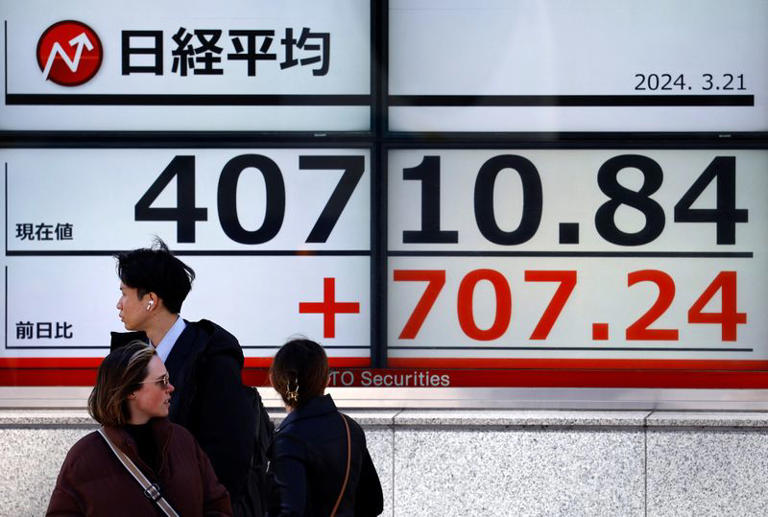Asian stocks were poised for a weekly gain on Friday, with the Nikkei reaching a record high, as investors reacted to a surprise rate cut by the Swiss National Bank (SNB), sparking speculation about potential moves by other central banks.
The SNB’s decision to lower rates by 25 basis points on Thursday injected fresh optimism into global markets, leading to a surge in risk sentiment. This momentum propelled Wall Street to close at record highs, further boosting investor confidence.
While MSCI’s broadest index of Asia-Pacific shares outside Japan experienced some profit-taking in early trading on Friday after a significant jump in the previous session, it remained on track for a weekly gain of more than 1%.
Several benchmarks in Asia, including Japan’s Nikkei and Taiwan’s weighted index, surged to record highs, with both indices set for weekly gains of nearly 6% and 3%, respectively. South Korea’s KOSPI also reached a two-year high.
Rob Carnell, ING’s regional head of research for Asia-Pacific, highlighted the positive impact of central bank easing measures, stating that such actions provide support to market sentiment and may lead to further easing expectations.
Traders wasted no time in adjusting their bets, particularly on potential rate cuts by the European Central Bank (ECB) and the Bank of England (BoE), following the SNB’s move. BoE Governor Andrew Bailey indicated a shift in stance, suggesting that the British economy is nearing a point where rate cuts could be warranted.
In response to the BoE’s decision, the sterling fell to a three-week low but later recovered slightly. Meanwhile, the Swiss franc, which had weakened more than 1% against the dollar following the SNB’s announcement, remained under pressure.
Jane Foley, senior FX strategist at Rabobank, suggested that the Swiss franc could continue to soften, particularly if the SNB signals readiness to align with potential rate cuts by the ECB.
In contrast to the positive sentiment in other parts of Asia, stocks in China and Hong Kong experienced a decline, with the CSI300 index dropping over 0.5% and the Hang Seng Index weakening by nearly 2%. This downward trend was attributed to the yuan’s depreciation beyond the 7.2 per dollar mark for the first time since November.
Despite the U.S. Federal Reserve’s dovish stance in maintaining its projection of three rate cuts this year, which initially caused the dollar to weaken, the currency quickly regained ground. The dollar’s strength pushed the yen closer to multi-decade lows, prompting Japanese government officials to intensify their verbal intervention efforts.
The dollar’s resurgence was fueled by robust U.S. economic data and the Bank of Japan’s rate hike this week, which failed to significantly impact interest rate differentials between the U.S. and Japan.
Meanwhile, the euro declined slightly to $1.0850, remaining within a narrow trading range observed for most of the year.
According to Rob Carnell, ING’s regional head of research for Asia-Pacific, the market’s anticipation of a weakening dollar has persisted for over a year. However, he noted that the strength of the U.S. economy casts doubt on this expectation, especially considering the potential actions of other central banks, particularly in the G10 countries.
In commodity markets, Brent crude fell by 43 cents to $85.35 per barrel, while U.S. crude decreased by 41 cents to $80.66 per barrel. Spot gold also experienced a slight decline, down 0.28% to $2,174.89 per ounce after reaching an all-time high on Thursday.
